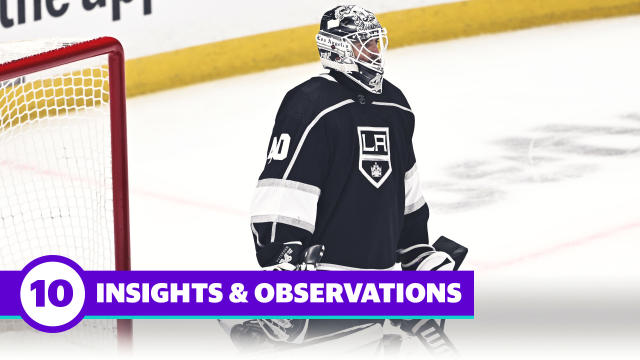When a hockey player is placed on waivers, they are made available to be claimed by other teams in the league. This process allows teams to potentially remove a player from their roster and create space for a new addition or make room for younger players.
Waivers give other teams the opportunity to claim the player and take over their contract, assuming their salary and other obligations. If no team claims the player within a certain period, usually 24 hours, then the player remains with their current team and can be assigned to a minor league affiliate or placed on the team’s inactive or taxi squad.
In the fast-paced world of professional hockey, teams constantly evaluate and adjust their rosters to optimize performance and fit within salary cap constraints. Placing a player on waivers is a strategic move that offers flexibility and potential opportunities for both the player and the team. This article will explore what happens when a hockey player is placed on waivers and the implications it has on their career and the team dynamics.
Table of Contents
- 1 The Waivers Process
- 2 Implications Of Being Placed On Waivers
- 3 Factors Influencing Waiver Decisions
- 4 Insider Perspectives
- 5 Notable Waivers Claims In Nhl History
- 6 Comparing Waivers Across Different Leagues
- 7 Waivers And Trade Deadline Dynamics
- 8 Controversies Surrounding Waivers
- 9 Waivers In The Eyes Of Fans
- 10 Evolution Of Waivers Rules
- 11 Future Trends In Waivers
- 12 Frequently Asked Questions For What Happens When A Hockey Player Is Placed On Waivers
- 12.1 What Does It Mean When A Hockey Player Is Placed On Waivers?
- 12.2 Why Do Hockey Teams Put Players On Waivers?
- 12.3 How Long Does A Player Stay On Waivers In Hockey?
- 12.4 Can A Claimed Player Refuse To Go To The Claiming Team In Hockey?
- 12.5 What Happens If A Player Is Not Claimed Off Waivers In Hockey?
- 12.6 Can A Team Withdraw A Player From Waivers In Hockey?
- 12.7 What Are The Implications Of Being Claimed Off Waivers In Hockey?
- 13 Conclusion
The Waivers Process
Understanding the waivers process in hockey is crucial for players and teams alike. When a player is placed on waivers, it triggers a series of events that can lead to changes in the team roster. Let’s dive into the key aspects of the waivers process:
Initiating Waivers
When a team decides to place a player on waivers, they must first notify the league. This action makes the player available to all other teams in a specified order based on their current standings.
Claiming Players Off Waivers
If a team wishes to claim a player on waivers, they must submit a claim to the league. The claiming team with the lowest win percentage has the first priority to acquire the player, followed by the rest of the teams in reverse order.
Clearing Waivers
Once a player is placed on waivers and no team claims them, they are said to have ‘cleared waivers.’ At this point, the player remains with their original team and can be moved between the active roster and the minors without restrictions.
Implications Of Being Placed On Waivers
When a hockey player is placed on waivers, it can have far-reaching implications for both the player and the team. Let’s explore the potential outcomes for players and the salary cap considerations that come into play.
Potential Outcomes For Players
Being placed on waivers means that a player’s contract is made available to all other teams in the league. This opens up several possibilities:
- The player may be claimed by another team. If this happens, the player’s contract is transferred to the new team, and they will join their roster.
- If no team claims the player within the waiver period, the player is said to have cleared waivers. They remain with their current team and can be assigned to their American Hockey League (AHL) affiliate or stay on the NHL roster as a healthy scratch.
- In some cases, a player might be assigned to the AHL or other minor league team before being placed on waivers. This decision is typically made to give the player more playing time or to manage the team’s salary cap situation.
- If a player is not claimed and does not have a two-way contract, they may be placed on unconditional waivers for the purpose of contract termination. This allows the team to buy out the remaining years of the player’s contract.
Salary Cap Considerations
Placing a player on waivers can also have significant salary cap implications for the team. Here are a few key points to consider:
- If a player is claimed by another team, their salary is now the responsibility of the claiming team. This removes the player’s salary from the original team’s cap calculation.
- If a player is not claimed and is assigned to the AHL or other minor league team, their salary may still count towards the team’s salary cap depending on the specific circumstances and contract details.
- If a player is bought out after clearing waivers, the team may still carry a portion of the player’s salary on their cap for a designated number of years.
- Teams must carefully consider the financial implications of placing a player on waivers, as it can impact their ability to make future roster moves or stay within the salary cap limits.
As you can see, being placed on waivers can have a significant impact on a player’s career and the team’s salary cap situation. It is a critical decision that teams must carefully consider before taking action.
Factors Influencing Waiver Decisions
Waiver decisions in hockey are influenced by player performance, team needs, and salary cap considerations. When a player is placed on waivers, teams weigh various factors before deciding their future with the team. Performance often plays a significant role in determining whether a player will successfully clear waivers.
Factors Influencing Waiver Decisions When a hockey player is placed on waivers, several factors come into play in the decision-making process. These factors can have a significant impact on the player’s future in the league and the team’s overall strategy. Understanding the key considerations that influence waiver decisions is crucial for players, coaches, and fans alike.Performance Metrics
Performance metrics play a pivotal role in waiver decisions. Statistics such as goals, assists, plus/minus rating, and time on ice are closely scrutinized to evaluate a player’s on-ice contribution. Key performance indicators like shooting percentage, save percentage, and faceoff win percentage are also taken into account. Teams assess various advanced metrics such as Corsi, Fenwick, and PDO to gain deeper insights into a player’s impact on the game.Team Needs
A team’s specific requirements and existing lineup heavily influence waiver decisions. Strategic alignment and player role fit are essential aspects considered. Teams evaluate whether the player in question meets the current needs of the team, such as filling a specific position, contributing to a particular playing style, or addressing a skill gap. Overall team dynamics and the impact of adding or removing a player from the roster are meticulously reviewed.Contract Status
The contractual situation of the player also weighs heavily in waiver considerations. Salary cap implications and potential long-term commitments are carefully evaluated. The player’s contract length, cap hit, and potential for a new contract are key determinants. Teams need to assess the financial implications of claiming a player off waivers and taking on their contractual obligations. In conclusion, waiver decisions are shaped by a combination of performance metrics, team needs, and contractual considerations. These factors collectively influence the direction of a player’s career within the league. Understanding the intricacies of waiver decisions is vital for all stakeholders in the hockey realm.
Credit: www.dkpittsburghsports.com
Insider Perspectives
Hockey waivers can be a pivotal moment in a player’s career, shaping their future in the NHL. The process of placing a player on waivers, and the subsequent response from player agents and team management, offers valuable insights into the dynamic and often challenging world of professional sports.
Player Agents’ Roles
Player agents play a crucial role in navigating the complexities of waivers. They are responsible for closely monitoring their client’s performance and contract status, ensuring that the player’s best interests are safeguarded throughout the waiver process. Agents must act swiftly and strategically, weighing the potential impact of waiver placement on their client’s career trajectory.
Team Management Insights
For team management, the decision to place a player on waivers is a multifaceted one, influenced by performance, team dynamics, and financial considerations. It offers a glimpse into the balancing act between nurturing talent and managing the team’s overall competitiveness. The waiver process underscores the intricate decisions that team management must grapple with, often with significant implications for the player and the team’s dynamics.
Notable Waivers Claims In Nhl History
Waivers in the National Hockey League (NHL) can significantly impact the careers of players and the fortunes of teams. When a player is placed on waivers, it means that he is made available to other teams in the league. The claiming team can assume his existing contract, but if no team claims the player within the specified period, he remains with his original team.
Impactful Transactions
Over the years, there have been several notable waivers claims that have had a significant impact on the NHL. These transactions have not only reshaped the fortunes of teams but have also propelled players to newfound success.
One of the most memorable waivers claims in NHL history happened in 1990, when the Detroit Red Wings claimed future Hall of Fame forward Brett Hull off waivers from the Calgary Flames. This move proved to be a game-changer for the Red Wings, as Hull went on to become one of the team’s most prolific goal scorers, helping them win two consecutive Stanley Cup titles in 1997 and 1998.
Another example of a consequential waivers claim occurred in 2002, when the Buffalo Sabres claimed goaltender Martin Biron from the Philadelphia Flyers. Biron went on to solidify the Sabres’ goaltending position and played a crucial role in their success in the subsequent seasons.
Success Stories Post Waivers Claim
Not all players who are claimed on waivers experience success, but some have transformed their careers after being given the opportunity by a new team. This exemplifies the potential opportunity for redemption that exists within the waiver system.
A prime example is goaltender Devan Dubnyk, who was claimed by the Minnesota Wild in 2015. Prior to the claim, Dubnyk had struggled to find consistency in his career. However, joining the Wild revitalized his performance, leading to a Vezina Trophy nomination and a revitalized reputation as one of the league’s top netminders.
Similarly, forward Rich Peverley was claimed by the Boston Bruins in 2009. Peverley proved to be a valuable asset for the Bruins, contributing significantly to their Stanley Cup victory in 2011.
These success stories highlight the potential for players to find their stride and contribute positively to their new teams after being claimed on waivers. It shows that the waiver system can provide a fresh start and a platform for players to showcase their skills.
Comparing Waivers Across Different Leagues
Discover how waivers impact hockey players in various leagues, shaping their career paths and team dynamics. A player’s fate hangs in the balance when placed on waivers, creating opportunities and challenges within the league landscape. Explore the differing outcomes and implications of waivers across these competitive hockey environments.
Key Differences In Waivers Process
Impact On Player Movement
When a hockey player is placed on waivers, the process and outcomes can vary significantly across different leagues. Let’s explore how waivers differ among various hockey leagues.
Key Differences In Waivers Process
Waivers in the NHL, AHL, and other hockey leagues have unique protocols. In the NHL, waivers give teams the opportunity to transfer a player from the active roster to the minor leagues or another team. However, in the AHL, waivers are used to redistribute players among teams within the same league. Understanding these variations is crucial for players and teams alike.
Impact On Player Movement
Placing a player on waivers can have a profound effect on their career trajectory. In the NHL, if a player is claimed off waivers, they are immediately transferred to the claiming team’s roster. This can lead to opportunities for players looking to showcase their skills in a new environment. Conversely, if a player clears waivers, they may be assigned to the minor leagues, impacting their playing time and visibility.
Waivers And Trade Deadline Dynamics
Strategic Waiver Moves Before Deadlines
Teams strategically place players on waivers to gauge interest from other teams before the trade deadline.
Effect On Team Rebuilding Or Strengthening
Waivers impact teams by either allowing them to rebuild by shedding contracts or strengthen by acquiring new talent.
Controversies Surrounding Waivers
When a hockey player is placed on waivers, it can often lead to controversies and discussions within the hockey community. The process of placing a player on waivers, where they can be claimed by other teams, has raised questions about fairness and transparency. Player reactions, as well as critiques on the fairness and transparency of the waiver system, have been hot topics of debate.
Player Reactions
Players who find themselves on waivers often experience a mix of emotions. While some may understand it as part of the business side of hockey, others may feel a sense of disappointment or frustration. Being placed on waivers means that their current team is willing to part ways with them, which can be a blow to their confidence and career. Additionally, the uncertainty of whether they will be claimed by another team adds to the stress and anxiety they may feel.
Critiques On Fairness And Transparency
The waiver system has faced criticism regarding its fairness and transparency. Some argue that the process lacks fairness as players are subject to being claimed by other teams without their consent or input. It can be seen as stripping them of their control over their own career paths. This lack of control has led to debates about whether players should have more say in the waiver process.
In addition, questions have been raised about the transparency of the waiver system. Some argue that the criteria used for determining which players are placed on waivers and which are not is not always clear. This lack of transparency has led to speculation and uncertainty within the hockey community. Critics suggest that more clarity and openness in the waiver process would help alleviate some of these concerns.
Overall, controversies surrounding waivers in hockey are centered around player reactions and critiques on the fairness and transparency of the system. As the hockey community continues to discuss and debate these issues, it remains to be seen whether any changes will be implemented to address these concerns.
Waivers In The Eyes Of Fans
When a hockey player is placed on waivers, it can create a stir within the fan community. Waivers can elicit a range of emotions and speculation from passionate fans who closely follow their favorite teams and players. Let’s delve into the intriguing world of waivers from the perspective of the devoted fan base.
Fan Community Reactions
The news of a player being placed on waivers can spark intense conversations and debates among fans. Some may express disappointment, while others might see it as an opportunity for the team to make strategic roster adjustments. The fan community often serves as a platform for the exchange of diverse opinions and sentiments, shaping the collective narrative surrounding the waiver process.
Predictions And Speculations
Amidst the placing of a player on waivers, fans are quick to engage in predictions and speculations about the potential outcomes. Speculations may revolve around whether the player will be claimed by another team, sent to the minor leagues, or retained by the current team. This lively anticipation and conjecture contribute to the dynamic and dynamic nature of the waivers process.

Credit: www.sportskeeda.com
Evolution Of Waivers Rules
When a hockey player is placed on waivers, it triggers a process that can potentially change the course of their career. The evolution of waivers rules has significantly impacted how teams manage their player rosters and make strategic personnel decisions.
Historical Changes In Waivers Protocols
The waiver system has undergone several changes over the years, reflecting the dynamic nature of the sport and its management. In the early days, waivers were primarily utilized to facilitate trades and were not a common practice. However, as the game and its business aspects evolved, waivers became a crucial component of managing player contracts and team roster compositions.
Impact On Modern Player Management Strategies
Modern player management strategies have been heavily influenced by the introduction of waivers rules. Teams must carefully weigh the implications of placing a player on waivers, considering factors such as salary cap implications, player development, and overall team performance. This has elevated the strategic complexity of roster decision-making, leading to a more nuanced approach to player management.
Future Trends In Waivers
As the world of professional hockey evolves, so too do the processes surrounding player transactions. One such process that has seen notable changes in recent years is the waivers system. This crucial aspect of the sport determines the fate of players who are put on waivers, and as technology advances and new rules come into play, the future of waivers is shaping up to be an intriguing one.
Technology’s Influence On Waivers Process
The rapid advances in technology are revolutionizing various aspects of the game, including the waivers process. With the introduction of sophisticated analytics tools and data-driven decision-making, teams now have access to a wealth of information that can aid in the evaluation of players on waivers. This ensures a more informed and strategic approach when it comes to selecting these individuals.
Furthermore, technology has streamlined the administrative side of waivers. Online platforms and digital documentation have replaced the cumbersome paperwork of the past, reducing the time and effort required to complete waivers transactions. This streamlined process not only benefits teams, but also allows players to quickly and efficiently move on to the next chapter of their careers.
Potential Rule Revisions
As the landscape of professional hockey continues to evolve, so too may the rules pertaining to waivers. Organizations closely examine the effectiveness and fairness of the current system, leaving room for potential revisions that aim to improve the process for all parties involved.
One potential rule revision could involve implementing a tiered waivers system. Currently, when a player is placed on waivers, any NHL team has the chance to claim them. However, this can result in more formidable players being continuously snatched up by stronger teams, leaving less talent available to the lower-ranking teams in need of reinforcements. A tiered waivers system could allow these lower-ranked teams the opportunity to acquire players without the fear of constantly losing them to more successful organizations.
Another potential rule revision is introducing a deadline for when players can be placed on waivers during the season. This would provide clarity and certainty for both players and teams, preventing last-minute surprises and giving players a fair chance to find new homes within a reasonable timeframe.
In conclusion, the future of waivers in professional hockey is an exciting one, as technology revolutionizes the process and potential rule revisions seek to level the playing field. The integration of advanced analytics and streamlined administrative procedures ensures a more efficient and data-driven approach. Meanwhile, potential rule revisions, such as a tiered waivers system and a deadline for waivers placements, aim to create a fairer and more balanced environment for teams and players alike.

Credit: ca.sports.yahoo.com
Frequently Asked Questions For What Happens When A Hockey Player Is Placed On Waivers
What Does It Mean When A Hockey Player Is Placed On Waivers?
When a hockey player is placed on waivers, it means the team is giving other teams a chance to claim that player.
Why Do Hockey Teams Put Players On Waivers?
Hockey teams put players on waivers to give them the opportunity to play with another team.
How Long Does A Player Stay On Waivers In Hockey?
A player stays on waivers for 24 hours, allowing other teams to claim them.
Can A Claimed Player Refuse To Go To The Claiming Team In Hockey?
No, a claimed player cannot refuse to go to the claiming team in hockey.
What Happens If A Player Is Not Claimed Off Waivers In Hockey?
If a player is not claimed off waivers, they remain with their original team.
Can A Team Withdraw A Player From Waivers In Hockey?
Yes, a team can withdraw a player from waivers if they change their mind.
What Are The Implications Of Being Claimed Off Waivers In Hockey?
Being claimed off waivers means the player moves to the claiming team, subject to league rules.
Conclusion
Being placed on waivers is a significant event for a hockey player, signaling a potential change in their career trajectory. It offers them a chance to be claimed by another team or be sent to the minor leagues. This process can be challenging, both mentally and emotionally, as players face uncertainty about their future.
However, it also presents an opportunity for growth and development, allowing them to showcase their skills to potential suitors. Ultimately, being on waivers is a crucial part of the hockey industry and can lead to new beginnings and fresh opportunities.
